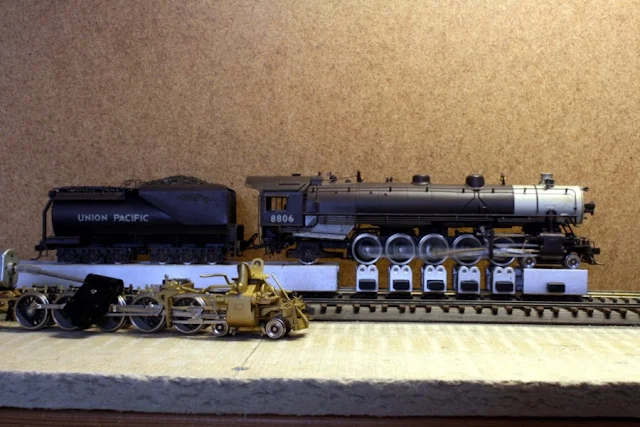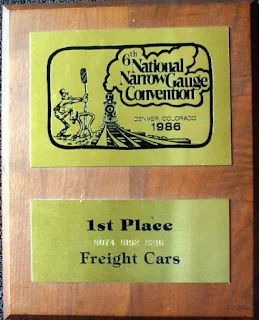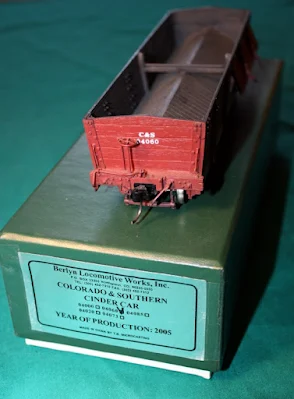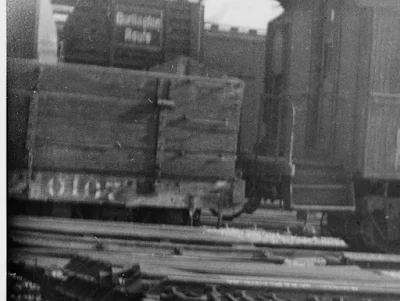Friday, November 17, 2023
Throwing Curves
The subjects of this post are two HO examples of the 4-10-2 "Overland" type with 3 cylinders built by Alco in the 1920s. More to the point it is about what can happen when models exceed the parameters of the layout they are expected to operate on.
In the early 1920s several
railroads purchased Alco's new Overland locomotive. In the early 1970s
Westside Models imported the U.P., S.P. and iirc A.T.& S.F. versions
 |
| WSM U.P. 4-10-2 running DCC & chassis of raw S.P. loco is ready to test |
Fifty
years ago the tightest HO radius could have been as little as 12" but
typically it was 15" to 18" inches. Not much has changed except perhaps
that there are fewer club layouts. Regardless, G-file 24 (and all of the
G-files) should be taken for what they were; advertisement. The 4-10-2s
may be able to negotiate some "pretty" tight curves but the true
minimum radius is the tightest curve a model can negotiated without any issues.
Furthermore, modelers today enjoy a plethora of large, mass produced models that are engineered to negotiate ridiculously sharp curves. A Rivarossi Bigboy, for instance, may well go around an 18" radius - I don't know - but to someone not familiar with the greater precision hand-crafted models of Yor it may be natural to assume negotiating really tight curves is universal to all models.
The owner of the 4-10-2s made statements to that affect. He has large plastic models that run thru his 24" curves. What would he expect? To him, the 2 models should run the curves and he was genuinely disappointed when they would not.
These are very heavy machines that are more inclined to force their way thru a curves than to jump the track. That of itself was deceiving and veiled what was really going on. The model was built by Katsumi, still one pf the best builders of all time. It was the importer who wrote the G-file that failed to be more concise.
Both raw 4-10-2s would go around the 30" S-curves on our test track. They would go around but they didn't like it and we would not presume that to be a proper minimum radius for the models. Sadly, even after all that we've done to 8806 we have little expectation it will run on the client's sharpest curves.
 |
| 30" S-curves of 7th Street Shops test track |
When they published G-file 24 WSM didn't anticipated the general impact DCC would have on brass models. DCC has revealed how forgiving DC is of electrical shorts. DC power is only seriously effected by a shorted condition; where there is a constant continuity below a certain threshold of resistance. For example, there is a manufacturing flaw, almost never detected by DC, that will consistently shut down a DCC system. A model with a shorted insulated driver is inoperable with DCC because the system safety will immediately "smell" it - even above a million ohms of resistance. Fortunately, shorted drivers are usually easy to fix but if you don't know to look for them you may wind up setting the model on the shelf.
The
raw DC 8806 tested acceptably on the 30" S-curves but after DCC was
installed it consistently shut down the system every time the model
backed into a curve to the left. To find the problem I start a process
of eliminating the usual suspects. The tender, pony truck and trailing
truck were removed in succession to narrow the scope of investigation.
The model continued to short in the same manner nonetheless. Since the
brake shoes are all plastic it began to look like the short was
somewhere in the insulated drivers. However, testing had already
established that none of the insulation was at fault. It seemed the only
answer was that one or more of the tires was able to contact the frame.
I ran the model in the dark to see sparks but none were observed. I
tried to insulate the frame from the backs of the drivers. That didn't
work.
 |
| Gear box disengaged to allow free rolling thru the curves |
More or less confident (or at least hopeful) I reassembled the entire
engine with the trucks and tender. The problem was finally fixed...
Right? Nope. Once again, as the model entered a left hand curve the
system shut down. Well!!
At this point it was clear that I was dealing with several shorts; a condition that is not very common.
 |
| With DCC 8806 running the S.P. chassis is ready to test for shorts |
Again I began eliminating parts of the model that were likely to cause trouble. First was the tender. Then I removed the pony truck. Yet each time the model approached the curve with the trailing truck leading there was a short. However, for the first time I saw an arc where the insulated wheel of the truck came into contact with the engine frame. Now it was additionally clear; WSM's Overland types required a minimum radius greater than 30". Apparently a "pretty tight curve" on a club size layout is on the order of 36". With a natural minimum radius well above 30" it is concluded that I was not fixing the faults of an otherwise nice model, I was modifying the parameters of an already nice model!.
After I fixed the final short in the pony truck the model was able to negotiate the 30" curves without shutting the system down. I contacted the client with an additional large bill that was solely the result of an expectation beyond the parameters of both model and layout. We decided to return the models and see if 8806 would go thru the 24" curve. I also retested the unpainted model. (I had since reinstalled the drawbar in order to return it with the 8806). As it rolled thru the curves I found that now it tripped the system when the boosters on the truck contacted the drawbar pin.
 |
| When frame backs into a left-hand curve, the system safety trips |
When I switched to Sn3 and began to plan the first layout I gathered examples of the engines I intended to use. Then I laid temporary curves of various radii and established a minimum operational radius. This, along with a minimum turnout angle, would be among the governing parameters of any Sn3 track plan.
The moguls and consolidation I would use were alleged to handle 22" curves. Unfortunately, such claims did not work for an operational minimum. Overland Models suggested 22" curves (iirc). That might seem reasonable since the Sn3 models are nearly the same size as larger HO models of the same types. Well, of course they should run around a broom handle! But they don't. My minimum radius turned out to be 30" not 22" and my sharpest turnout became a no. 7. If I ran the big K models that P-B-L offered the minimum curve would be 34" even though they suggested 28". The mechanisms may actually negotiate those curves but that is not all of the considerations. I came to realize that it is better to give up a little real estate for better operation than to try to shoehorn every whim into a few square feet. Knowing what the layout can handle and using models that are within those bounds seems best for fun and satisfaction.

















































